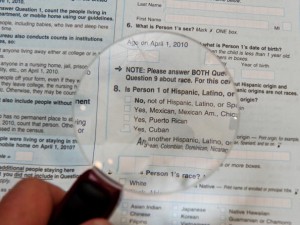A debate rages on in neighboring Maryland over the Dream Act which, if passed, would allow undocumented immigrant students to qualify for in-state college tuition. Some documented immigrants have come out against the measure, although they represent a minority of the state’s immigrants who are mostly Hispanic and come from mixed-legal status families, The Washington Post reports.
Homeless Shelter Leaving Logan Circle
Central Union Mission has been a Logan Circle institution for 28 years, but the homeless shelter is preparing to relocate to downtown. Borderstan interviewed the organization’s executive director David O. Treadwell about how the neighborhood has changed and what the area’s homeless will do after the organization moves.
Are Pilgrims the First Undocumented Immigrants?
Thanksgiving is nearly here, and no doubt that children around the country have been learning the traditional Thanksgiving story of how pilgrims broke bread with Native Americans. These early settlers are celebrated in American culture, from school plays to Charlie Brown specials. But how do early European pilgrims differ from today’s undocumented immigrants? That’s the provocative question raised by this week’s New Yorker cover, which depicts a group of early pilgrims illegally crossing the U.S.-Mexico border.
D.C.’s Rising Home Prices By Neighborhood
People purchasing homes in many D.C. neighborhoods are buying them for more than the asking price, a sign of D.C.’s robust housing market, Washington Business Journal reports. One such neighborhood is Anacostia, where some fear displacement of low-income and black residents.
Increasing home values fuel gentrification. With such a tight housing market, the option to sell becomes enticing to homeowners, particularly those who bought their homes years ago for much lower prices. Longtime homeowners may walk away making money, but neighborhood income diversity could decrease as only wealthier people can afford such home prices.
Occupy Movement: Racial, Gender Preferences When Calling Upon Reporters
Washington Post reporter Tim Craig tweeted from an Occupy DC rally at McPherson Square about racial and gender preferences when calling upon reporters. The “progressive stack policy” is typical at Occupy movement events. “For those of you unfamiliar, progressive stack just means encouraging people from marginalized communities to speak more often,” tweeted @OccupyKSt. Washington City Paper reporter Lydia DePillis pointed out, however, that such a policy relies upon visual markers.
What’s your take: do you think this method compensates for a lack of voices from marginalized communities? Is it an unfair to have such preferences over which reporters get first access? Should journalists not be bound by this policy, since they strive to be neutral news gatherers? Sound off in the comments below.
Complex Answers to ‘Where Are You From?’

Paul J. Richards / AFP/Getty Images
The U.S. Census form first asks respondents whether they are Hispanic or Latino and then asks about race.
By A.C. Valdez
Asking someone “Where are you from?” may seem simple enough, but it’s actually a tricky question, particularly for mixed-race Latinos. For instance, before asking your race, the U.S. Census form asks whether you are Hispanic or non-Hispanic. What if you identify as both?
My father is a genealogy buff, and although I’ve generally been uninterested by it, I do owe it to him that I know at least a bit about where I come from. My ancestry is quarter German, quarter Irish and half Chicano. My father grew up in South Texas, an area heavily populated by Latinos. For many Americans, that would seem to indicate that most residents are immigrants who recently settled in the area. But going back far enough, it’s likely that my ancestors have been around since Texas was first colonized by Spain. In other words, the border crossed us, not the other way around.
‘Illegal’ Or ‘Undocumented?’
There are a number of ways to refer to immigrants living in the United States without proper authorization, such as undocumented immigrants, illegal aliens and unauthorized immigrants. But which term should be used by media organizations that want to remain objective and avoid the appearance of bias? Our sister blog Multi-American lays out the arguments in the debate over immigration and terminology.
Turkey Giveaway Brings Cheer to Ward 8
With Thanksgiving only a few days away, a number of D.C. individuals and organizations are giving away turkeys to folks in need. Convenience store owner Ephrame Kassaye gave away 375 turkeys to Ward 8 residents during a weekend block party. “Without the people who live in the community, I am nothing,” Kassaye told The Washington Post‘s Theola Labbé-DeBose. “I just want to tell them thank you. They deserve this.”
Occupy Movement and Race

Nicholas Kamm / AFP/Getty Images
Occupy DC protestors march to the Key Bridge in Washington, D.C. on Nov. 17 during a day of protests in a show of force by the Occupy Wall Street movement.
By Bridget Todd
Originally posted on Racialicious, republished with permission.
People often tell me that I don’t look like your average Occupy protestor. I was initially drawn to the Occupy movement for several reasons. As an educator, anything that gets young people paying attention to the world around them is something that I feel the need to support. As an activist and organizer, I generally believe in the need for all citizens to engage in this kind of political discourse. As a black woman, I feel any conversation about economic inequality is incomplete if it doesn’t also address racial inequality as well. The various occupations across the country present spaces for such conversations to take place. I’ve found plenty of reasons to support the Occupy movement, but does the movement support me?
Portraits of American Poverty
Check out these haunting images from TIME magazine, captured by German-based photojournalist Joakim Eskildsen. He traveled around the country, from Native American reservations in South Dakota to post-Katrina New Orleans, photographing Americans struggling in the current economy.
Although Eskildsen didn’t take photos of people in D.C., he very well could have; about 1 in 5 District residents live below the poverty line, although that number could actually be higher under a new government measure.









